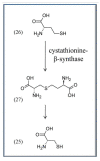Vitamin B6: a molecule for human health?
- PMID: 20110903
- PMCID: PMC6257116
- DOI: 10.3390/molecules15010442
Vitamin B6: a molecule for human health?
Abstract
Vitamin B6 is an intriguing molecule that is involved in a wide range of metabolic, physiological and developmental processes. Based on its water solubility and high reactivity when phosphorylated, it is a suitable co-factor for many biochemical processes. Furthermore the vitamin is a potent antioxidant, rivaling carotenoids or tocopherols in its ability to quench reactive oxygen species. It is therefore not surprising that the vitamin is essential and unquestionably important for the cellular metabolism and well-being of all living organisms. The review briefly summarizes the biosynthetic pathways of vitamin B6 in pro- and eukaryotes and its diverse roles in enzymatic reactions. Finally, because in recent years the vitamin has often been considered beneficial for human health, the review will also sum up and critically reflect on current knowledge how human health can profit from vitamin B6.
Figures





Similar articles
-
Vitamin B6: a long known compound of surprising complexity.Molecules. 2009 Jan 12;14(1):329-51. doi: 10.3390/molecules14010329. Molecules. 2009. PMID: 19145213 Free PMC article. Review.
-
Vitamin B6 deficient plants display increased sensitivity to high light and photo-oxidative stress.BMC Plant Biol. 2009 Nov 10;9:130. doi: 10.1186/1471-2229-9-130. BMC Plant Biol. 2009. PMID: 19903353 Free PMC article.
-
Vitamin B6: Killing two birds with one stone?Phytochemistry. 2010 Apr;71(5-6):495-501. doi: 10.1016/j.phytochem.2009.12.015. Epub 2010 Jan 19. Phytochemistry. 2010. PMID: 20089286 Review.
-
Vitamin B6 metabolism in microbes and approaches for fermentative production.Biotechnol Adv. 2017 Jan-Feb;35(1):31-40. doi: 10.1016/j.biotechadv.2016.11.004. Epub 2016 Nov 24. Biotechnol Adv. 2017. PMID: 27890703 Review.
-
Vitamin B6 and Diabetes: Relationship and Molecular Mechanisms.Int J Mol Sci. 2020 May 23;21(10):3669. doi: 10.3390/ijms21103669. Int J Mol Sci. 2020. PMID: 32456137 Free PMC article. Review.
Cited by
-
Pyridoxine Deficiency Exacerbates Neuronal Damage after Ischemia by Increasing Oxidative Stress and Reduces Proliferating Cells and Neuroblasts in the Gerbil Hippocampus.Int J Mol Sci. 2020 Aug 4;21(15):5551. doi: 10.3390/ijms21155551. Int J Mol Sci. 2020. PMID: 32759679 Free PMC article.
-
Protective effects of vitamin B6 alone and in combination with L-cysteine and NaHS on ethanol and indomethacin-induced gastric lesions in mice.Iran J Basic Med Sci. 2015 Mar;18(3):253-8. Iran J Basic Med Sci. 2015. PMID: 25945238 Free PMC article.
-
Potential Drug-Nutrient Interactions of 45 Vitamins, Minerals, Trace Elements, and Associated Dietary Compounds with Acetylsalicylic Acid and Warfarin-A Review of the Literature.Nutrients. 2024 Mar 26;16(7):950. doi: 10.3390/nu16070950. Nutrients. 2024. PMID: 38612984 Free PMC article. Review.
-
Methionine and vitamin B-complex ameliorate antitubercular drugs-induced toxicity in exposed patients.Pharmacol Res Perspect. 2017 Oct;5(5):e00360. doi: 10.1002/prp2.360. Pharmacol Res Perspect. 2017. PMID: 28971606 Free PMC article.
-
Water-soluble vitamins in people with low glomerular filtration rate or on dialysis: a review.Semin Dial. 2013 Sep-Oct;26(5):546-67. doi: 10.1111/sdi.12099. Epub 2013 Jul 17. Semin Dial. 2013. PMID: 23859229 Free PMC article. Review.
References
-
- Brouwer D.A., Welten H.T., van Doormaal J.J., Reijngoud D.J., Muskiet F.A. Recommended dietary allowance of folic acid is insufficient for optimal homocysteine levels. Ned. Tijdschr. Geneeskd. 1998;142:782–786. - PubMed
Publication types
MeSH terms
Substances
LinkOut - more resources
Full Text Sources
Other Literature Sources

